What part of your life is not powered by electricity? That's why you're here, reading this. You want to know how you can make electricity do even more Goodbye Power Company:Why You Can Soon Generate Your Own Electricity Goodbye Power Company:Why You Can Soon Generate Your Own Electricity Solar power enables clean generation of electricity, using a source that is guarantees that it will never run out in our lifetime, the sun. But will it ever beat the energy companies? Read more for you! Do you want to make your life greener? Make your wallet a little fuller? Not be so dependent on the power company? Maybe all of the above?
You can by installing a solar photovoltaic (PV) electrical system. What is solar power and why hasn't it taken off? What is solar energy and why hasn't it been removed? What is the problem with solar energy? If it really is as important and necessary as many claim, why hasn't it taken over the energy industry yet? Read more.
DMSOLAR - 7,500 Watt Complete PV System (Only $2.24/W!!) DMSOLAR - 7,500 Watt Complete PV System (Only $2.24/W!!) Buy Now On Amazon $16,718.00
“But it's so expensive!” you say. Well yes, you could easily spend $30,000 to $40,000 on a complete system. At the end of this article, we will see how you can do that much more affordable. Maybe even cut the cost in half.
Before we get into the different solar electric systems, let's take a few minutes to think about what we need and want.
People looking to use the sun to power their home do so for any of the following reasons:To save money How a smart energy monitor can save money and give you peace of mind How a smart energy monitor can save money and give you peace of mind Smart energy tells you how much electricity your appliances use and how much money you could save if you turned them off. They can also help you create intelligent smart automations. Read More 7 Energy Saving Technologies to Reduce Your Home's Carbon Footprint. 7 Energy Saving Technologies to Reduce Your Home's Carbon Footprint. The following energy saving technologies can be introduced into our homes to reduce our environmental impact. Not all of them will be affordable just yet, but we expect all of them to become the norm in the near future. Read More The Oil Killers:When Google Data Meets the Visions of Tesla and the Brains of MIT. Saving invention. This article connects the dots between three different technologies that, when put together, will change the world. Read more . Which of those is the most important to you? Which is the least important? Take the time to think about it.
There are other things you might want that you haven't thought of. You may want a system that you can have installed and just forget about it; Low or no maintenance. Maybe you want a system that doesn't affect your energy use habits 5 Smart Hacks to save electricity in your smart home 5 Smart Hacks to save electricity in your smart home The trick to saving electricity is to know where most of your energy is consumed. Energy. Read More

Do you care what the system looks like? Do you need something compact, or do you have room to spare? Are you subject to homeowners associations and covenants and want to make sure you don't violate them? These are all things to consider when deciding on the right system for you.
Also talk about it with your family. This is a decision they will have to live with. It may affect them in ways you haven't considered, but they'll be quick to point out once the system is in place. Remember, electricity affects everything we do.

Once you've got those things figured out and written down, you'll need to start thinking about the numbers that will shape your options even more.
How much electricity you need and for how long are the more specific questions. It's a matter of looking at your current electricity bills to see how much you use in a year, what your peak usage months are, and how long you need to be able to be off the grid How to use a battery bank to protect your home from power outages How to Use a Battery Bank to Protect Your Home from Outages Your office computer can keep going during a power outage because it has a UPS. Can you put your whole house on a UPS? Yes. Yes you can. Read more.
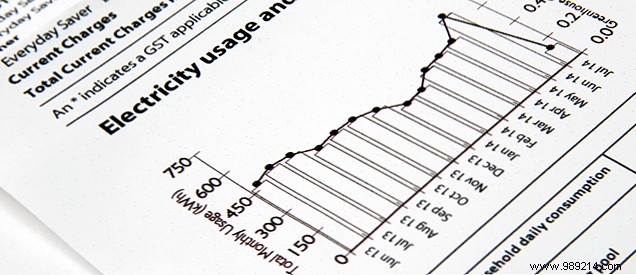
We've talked pretty extensively elsewhere about how to determine your energy needs. Tesla's battery could change the world. But does it really save you money? Tesla's battery could change the world, but does it actually save you money? Innovation has a cost. One of the hopes in energy innovation is that there will eventually be a financial payoff. Tesla's battery is no different. Read More Be sure to record those numbers. It would be nice to put them in a spreadsheet so you can work with them. Being able to test different scenarios can help you save a lot of time and money.
There are two categories of solar PV systems:grid-connected and off-grid. When we say grid, we mean the system of power lines that your power company uses to provide you with electricity. Seen from above, it looks like a grid. The grid-tied system will keep you connected to the power grid and your electric service. Systems outside the network will not have a connection to the network. This is how and why the Amish live off the grid. This is how and why the Amish live off the grid. There is a group of traditionalist people who reject many of the technologies of modern society, including public grid electricity:the Amish. That, however, does not prevent them from enjoying some of the comforts of technology. Read More
Each category has a few different variations. Grid connected systems will have a series of batteries as a backup system, or not, or they may have a generator as well. Off-grid systems should always have battery array backups. The two main isolated systems will be PV only, and hybrid systems that combine your solar panels with wind, micro-hydro, a generator, or any combination of these.
The categories, and each system within those categories, have their pros and cons. Of course, what is positive or negative is a matter of perspective. Before we get to the specific systems, let's look at the basic components of each.
All of these systems will have some common parts. The most obvious part is the efficient solar panels. Cheap. Incredible. Here's why the new aerosol solar cells are efficient. Cheap. Incredible. This is why new sprinkler solar cells matter spray process. Read more . That's the point where sunlight is converted into direct current (DC) electricity through the magic of the photovoltaic cell.
Renogy 100W Polycrystalline PV Solar Panel Module Renogy 100W Polycrystalline PV Solar Panel Module Buy Now On Amazon $109.99
Your panels will most likely be mounted to your roof, however you may have separate mounts that you put up on your property. You can even get solar tracking mounts to ensure the panels receive the optimal amount of sun each day. The options here are changing all the time, becoming easier to install and more pleasing to the eye.
Grape Solar GS-5300-R-ASD Direct Mount Rack Mount System for Twenty 60 Cell Solar PV Panels, Asphalt Shingle Buy Now On Amazon $3,485.06
Inside the house, DC electricity will be converted to alternating current (AC) electricity to power your everyday appliances. This is the investor's job.
Depending on the system you go with, this inverter can also provide a connection to the grid. That is, it will regulate whether or not the electricity you generate is sent to the power lines. If the power coming from the grid drops, the inverter will stop feeding into the grid. That's for the safety of anyone working on power lines.
If your system is going to have battery backup, your inverter may also have a charge controller function. It will take on the role of diverting excess electricity to charge the batteries, literally for a rainy day. It may also have a charge controller which is a separate component. Not necessarily a bad idea as it can be replaced separately from your inverter if it fails.
Magnum Energy MS4448PAE MS-PAE Series 4400W 48VDC Pure Sine Inverter Charger; Provides multiple ports, including an RS485 communication port for network expansion, and a remote port Magnum Energy MS4448PAE MS-PAE Series 4400W 48VDC Pure Sine Inverter Charger; Provides multiple ports, including an RS485 communication port for network expansion and a remote port Buy Now On Amazon $1,815.16
Grid-connected and off-grid systems with battery backup will also have batteries. These batteries must be stored properly. How a battery works and 3 ways you can ruin it. How a battery works and 3 ways you can ruin it. The modern battery is found in many of our favorite technologies, so it can hardly be forgiven. spend time learning how it works. Read More Unless you go for the Tesla Powerwall Did Elon Musk save us from fossil fuels? Did Elon Musk save us from fossil fuels? Read more, of course.
Mighty Max Battery 12V 100AH DEEP Cycle VRLA Solar Wind Battery 12V 24V 48V Brand Product Mighty Max Battery 12V 100AH DEEP Cycle VRLA Solar Wind Battery 12V 24V 48V Brand Product Buy Now On Amazon $174.99
A disconnect switch is also important. Think of it like a safety switch. If something happens to your system and you need to shut it down quickly, this is the device for you. Make sure everyone in your family knows where to find it and how and when to use it.
MidNite Solar PV Disconnect Combiner MNPV6 MidNite Solar PV Disconnect Combiner MNPV6 Buy Now On Amazon $172.51
There will also be a variety of cables to connect everything, fuses to protect everything, and mounting hardware to secure everything. These are the basic components of any solar electrical system..
We live in all kinds of homes in all kinds of places and have all kinds of different lifestyles. The energy needs of each home are different. So how do we compare the systems we're looking at?
Let's use a standardized house and base everything on that. This will give most people a good idea of what their situation will look like.
Our home example is a 1,600 square foot. house located in Massachusetts, so it has a temperate climate with cold and snowy winters. It uses approximately 7400 kWh/year at a cost of around $1,036. Now that we've figured it out, we can talk about numbers when looking at different systems. Let's get to that.
Off-grid systems are best suited for buildings far from the nearest power line. This could be your new country home, or maybe a family home. The people who are best suited for off-grid systems are people who are already very energy conscious.
They have already adopted as many energy saving strategies as they can. They have gotten as far as they can without being disconnected from the network. They're going into this with their eyes wide open, and so should you. If this is you, or who you want to be, keep reading.
Pros: Eliminate energy bills, network outages, and grid dependency.
Cons: You need to adjust your power usage habits, and a system malfunction could leave you without power for days.
This is the basic solar electrical system. Panels, charger, inverter and batteries. That's all about it. However, just because it's that simple doesn't mean it's the cheapest. You will be completely dependent on this system for all of your electricity, so it will also be the largest of the PV systems. It will require most panels and most batteries, because if the sun isn't shining, it's not getting power.
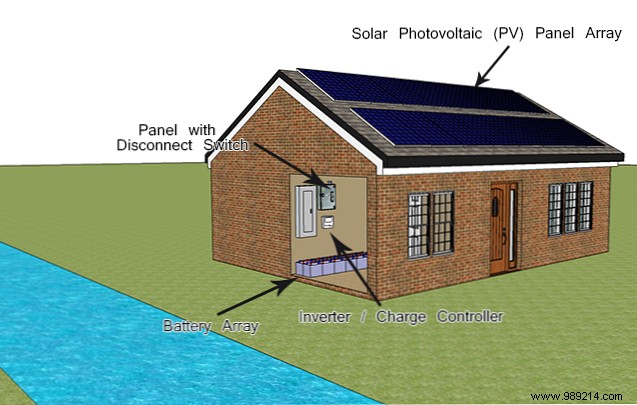
For our example home, this system would cost about $45,000, or $6 per watt of generating capacity. Even at that cost, your payback period Save energy and money with these smart home devices Save energy and money with these smart home devices One of the biggest benefits of a smart home is the available energy-saving technology. In addition to saving money, you'll also be pushing toward a more sustainable and convenient living situation. Read More Remember, we're going to look at ways to drastically reduce that near the end of this article.
Also, if this system is working in a new house, consider the cost of bringing electricity to the house. If you are very rural, you may have to pay to have poles built and power lines run. Expect to pay around $5 to $10 for every foot between the last current pole and where you need electricity. That can easily add up to ten or twenty thousand dollars. If your off-grid system cost $40,000 and you would have needed to run poles at $20,000, it paid for itself very quickly.
Pros: Completely off the grid, almost maintenance free.
Cons: High initial investment, longer payback period, long periods of low sun can wear out the system.
Sometimes the sun is not enough. Sometimes you are lucky enough to have other sources of energy that are more consistent or easier to tap into. If you have steady winds or a free-flowing stream on your property, you may want to take advantage of those with a wind turbine, micro-generator, generator, or some combination of these.
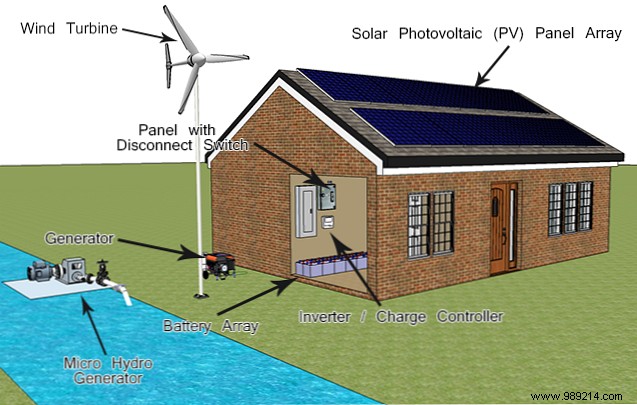
However, as with any other system, the more you add to it, the more complicated it becomes and the more maintenance it will require. But you've already decided to live off the grid, so you're probably fine with those concessions.
The best part of adding wind or hydro power is that you can increase your uptime to almost 100%. The wind blows at night and especially well on days without sun. The river runs as long as there is water in it. The generator will work as long as you have fuel, of course.
The cost of a hybrid system could vary dramatically. A 3 kW wind turbine and mounting tower can cost around $4,000 or $3 per watt. That's half the cost per watt for solar power alone.
ALEKO WG3KW48VSET Wind Generator Set Turbine Charge Controller and Inverter Green Renewable Energy ALEKO WG3KW48VSET Wind Generator Set Charge Turbine Charge Controller and Inverter Green Renewable Energy Buy Now On Amazon $2,469.99
A 1.5 kW micro generator costs around $3,000 or $2 per watt. That's a third of the cost per watt of a solar PV system.
A 10,000W Gas Generator Solar Generators vs Fuel Generators:Which is Best for You? Solar Generators vs Fuel Generators:Which is Best for You? Would a solar generator make more sense than a gas generator? What solar generator options are there? Those are the questions we will look at today. You can get more for less than $900. Of course, you also have to pay for gas. Generally, these generators need to be started manually when you don't have power. They also have small gas tanks, so their run time may not be as long as desired. In this case, consider a propane generator.
DuroMax XP10000E, 8,000 Running Watts / 10,000 Starting Watts, Gas Portable Generator DuroMax XP10000E, 8,000 Running Watts / 10,000 Starting Watts, Gas Portable Generator Buy Now On Amazon $929.95
Propane-powered generators can be had for around $3,000 and come with a host of other features, like automatically turning on or off depending on whether the rest of your system is generating enough power. They are also much more efficient and have a much longer run time than a gas generator.
Briggs &Stratton 40450 10000 Watt Home Standby Generator System with 200 Amp Automatic Transfer Switch Briggs &Stratton 40450 10000 Watt Home Standby Generator System with 200 Amp Automatic Transfer Switch Shop Now On Amazon $2,999.00
You can see how upgrading your system with any of these can help provide the same amount of electricity, more reliably, for much less money. Our example home system may now cost around $30,000. That's about 2/3 of what the solar PV system might cost.
Pros: Less expensive than solar PV alone, more consistent power generation.
Cons: More maintenance than solar PV alone, could require government approval for wind turbines or micro generators.
When you talk on a network, energy independence is usually not your main goal. What you are looking for is to save, or even make money. With many power companies buying your power at favorable rates, known as feed-in tariffs, this is definitely possible. You could even earn money.
A grid-connected system is still a boon to the environment, so you get the satisfaction of greening your world. It also has the convenience of constant power, no matter how little or how much you use. However, a little diligence in power will increase your total feed rates and add to your pockets more quickly.
Pros: Potentially 100%, energy usage habits don't have to change so drastically, it's possible to eliminate energy bill or even make money.
Cons: It still depends on the network.
This system is almost the same as an off-grid only PV system, except your inverter will also provide an interface to the grid. It will automatically manage your connection, allowing your surplus energy production to flow back into the grid. When you're not overproducing, it will allow grid power to continue flowing into your home.
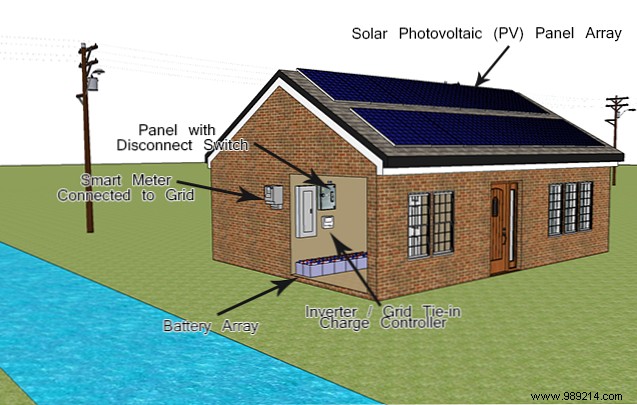
The advantage is that this system will allow your battery pack to continue powering your home when the grid is out of service. The duration of your home power will depend on the size of the battery and how you adjust your power consumption.
A system with a battery of batteries that will give the example a backup power source sufficient for 48 hours will cost around $40,000, while one providing enough for 6 hours will cost around $27,000. Of course, if you use Tesla Powerwalls, you can greatly reduce those costs. It will also save you space.
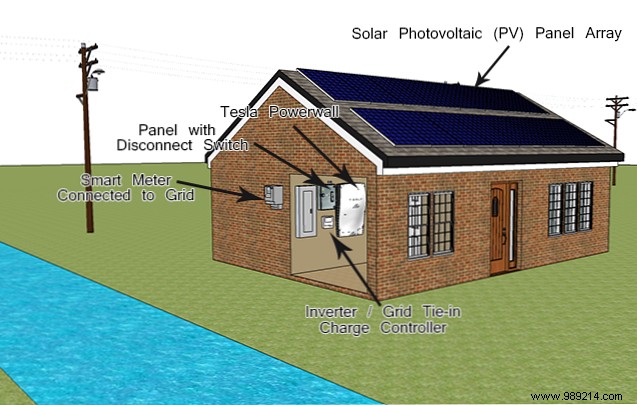
Sure, this system is potentially twice as expensive as a photovoltaic system, connected solely to the grid. However, this system is ideal for people who rely on home medical equipment, are subject to frequent power outages, or work from home How to work from home and be productive with online collaborative tools How to work from home and be productive with online collaborative tools Would you like to be able to skip the commute and work from home? Remote work also has its drawbacks. We show you how to harness the power of the Internet to stay productive while working remotely. Read more . For these people, it might be worth it.
Pros: Best power-up time of all systems if battery pack is big enough.
Cons: More maintenance, more expensive, a longer payback period, and takes up more space than a grid-connected PV-only system.
The grid tied PV only system is simply panels, cables and a grid tie inverter. It is the least expensive whole house system. In our example home, a system that would replace grid power comes in at around $32,000. This is the system you choose if your budget is limited and you want to quickly reduce energy costs. It can benefit almost anyone, right away.
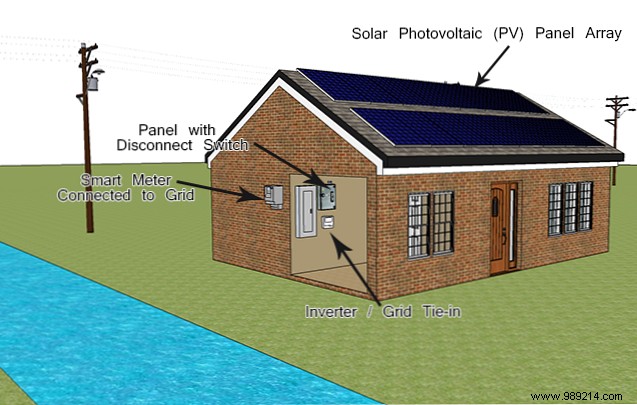
It is important to remember, this is a system that can be built on. You can start here, then add a battery backup, then continue until you're off the grid. If your house allows it, you could add wind turbines and micro hydro.
Pros: Less expensive and less maintenance than battery backup system.
Cons: Grid power outages will affect you in the same way as just being on the grid.
If you can't question a whole home system right now, consider a small system like a home solar power kit. How Home Solar Power Kits Can Keep You Online During Outages. How home solar power kits can keep you online during outages. Generators are well known, the same is not true for residential solar power kits. There are thousands of products on offer, each with its own advantages and disadvantages. Which ones are suitable for... Read More They come in different sizes and prices. It may be enough to keep your phones and laptops charged, or to run important equipment like a home dialysis unit or sump pump.
Goal Zero Yeti 1250 Solar Generator Kit with Boulder 30 Solar Panels Goal Zero Yeti 1250 Solar Generator Kit with Boulder 30 Solar Panels Buy Now on Amazon
Like isolated systems, you can add other sources of generation, such as a wind turbine or micro-hydro generator. People who are still tied to the network generally don't use them, because they are redundant or because the neighbors consider them an eyesore. The government may even have regulations against wind or micro-hydro turbines in residential areas.
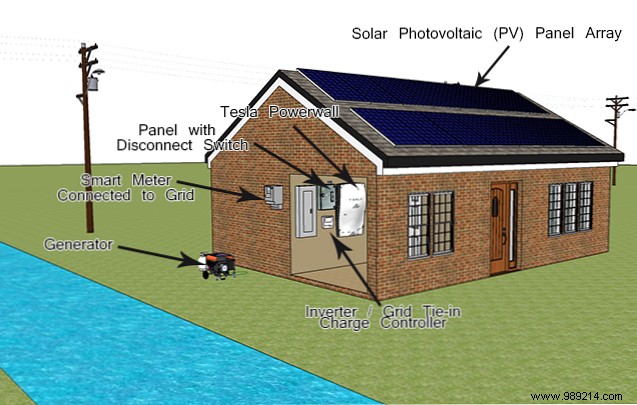
What you will probably see is a generator connected to the system. This is the best and least expensive way to get the kind of power-up time that a battery backup system could give you. Gas generators are fairly inexpensive, but you might consider a more expensive diesel or propane generator. Some of these can even be configured to start automatically when a power outage is detected.
Pros: Excellent uptime, between the cost of a PV alone and a PV with battery backup system. It often starts and stops on its own depending on the power of the network.
Cons: Requires more upkeep than just HP. Generator noise may not be welcomed by neighbors or local government.
How can you not?
Depending on where you live, there could be federal, state, and even municipal incentives that could cover up to half the cost.
Our example home in the US is eligible for 30% Federal Income Tax Credits for energy efficiency, through December 31, 2019.
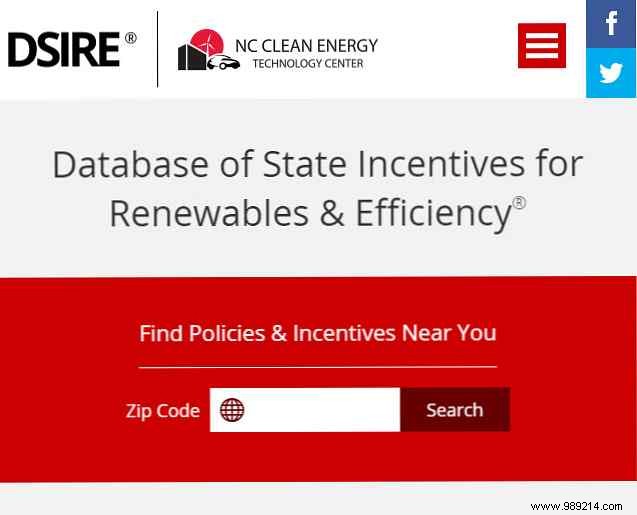
In Massachusetts, the state of our home example, there are 4 other incentive programs to make this more affordable; Net metering, sales tax exemption, personal tax credit, and property tax incentive.
Net metering could bring your energy bill down to zero in Massachusetts. That is all your law allows at this time. If there are feed-in fees in your area, it could go beyond just eliminating your power bill; You could end up being paid by them.
Eligible solar photovoltaic systems and components are also exempt from state sales tax. While that doesn't reduce the base cost for the system, it's a relief that you don't get sales tax as well.
Massachusetts will also give you a personal tax credit of up to $1,000 for installing an approved system. Between that and the federal income tax credit, you could get a hefty tax return.
Finally, if your system increases the value of your property (and it will), the amount that is increased is exempt from property tax for 20 years.
Our example home's grid-only PV system has now been reduced from $32,000 cost to $22,300 out of pocket after taxes. This is getting good.
At your location, there may be feed-in fees or even higher incentives. Depending on the details, it could cut the initial cost in half. Search your zip code in the Database of State Incentives for Renewables and Efficiency.
Now, consider your current and future cost of the electrical grid. It's not cheap now, and you'll probably never get it cheaper. Keep in mind that the cost of energy has averaged an inflation rate of 3.15% per year, from 1960 to 2011. That's according to the US Energy Information Administration. Numbers may vary in your location.
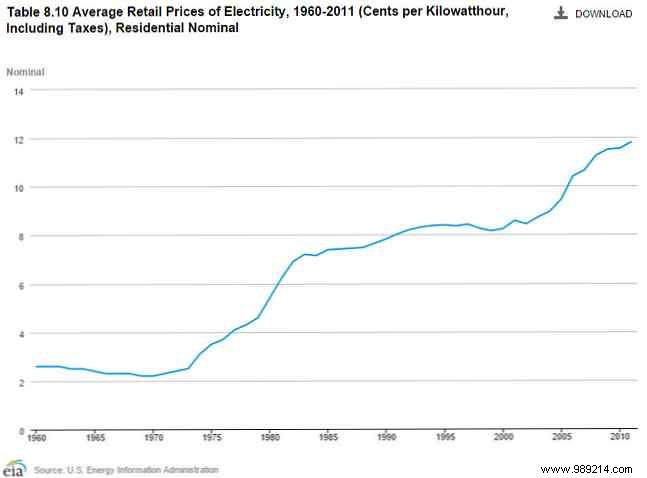
Assuming your net metering brings your energy bill down to zero, and the cost of energy inflation rate stays the same, the system pays for itself in just 12 years. That may seem like a long time. However, the service life of the system can be 20-30 years. By year 30, the system could have put another $36,000 in your pocket.
Now you know the systems available to you. You also have an idea about their implementation cost and how they can pay for themselves. You are thinking about the negative and positive aspects of each system. That's good.
Note that these systems can be built in an almost infinite number of ways. You're not stuck with the first system you get.
Maybe you start with just grid tie PV, then add batteries until you have a full backup. You can then disconnect from the network when you are sure your system will meet all your needs.
Or you can start with a small grid tie system, just for PV, but then add wind turbines or micro generators. Then, when you're comfortable keeping them, you can recharge the battery and go offline.
So the best system for you is what you can use right now. Cuando la vida cambie, puede adaptar estas cosas para satisfacer sus necesidades y convertirlo en el mejor sistema para usted..
Con suerte, hemos respondido la pregunta de qué sistema es el mejor para usted. Sin embargo, con el precio de la electricidad en constante aumento, el estado del medio ambiente se está degradando y el costo de estos sistemas disminuyendo de manera casi exponencial, llegará un momento en que cómo hazlo será la única pregunta.